The Voice starts its 11th season tonight, which only serves to remind me of the real deal (celebrated in this post from 2014).
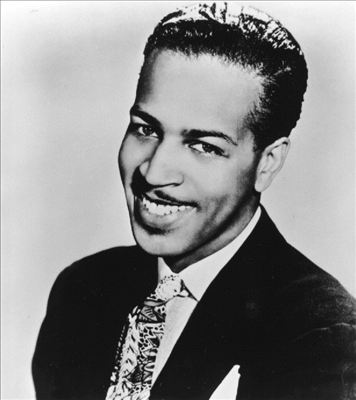 Let us now praise Wynonie Harris – a truly badass blues shouter who would send the smug, preening judges on [insert name of TV talent show du jour here] running for their lives.
Let us now praise Wynonie Harris – a truly badass blues shouter who would send the smug, preening judges on [insert name of TV talent show du jour here] running for their lives.
Yes, we’re a little starstruck when it comes to the man they called Mr. Blues. Here’s just two reasons why he’s on our shortlist of roots music heroes:
1. The great American drinking song… We covered this grand tradition here and here, and both posts feature towering achievements of the form by Harris, who spent most of his life conducting extensive research on all things alcohol. Here’s another shot of the good stuff: Drinking Blues
2. The great American “let’s get it on” song… That’s right, long before J-Lo sang the praises of her own booty and Marvin Gaye healed our sexuality, Wynonie cranked up the carnal heat with frisky little numbers like this one: Keep On Churning
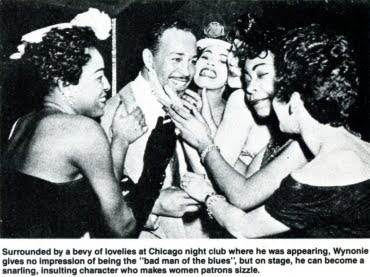 Harris also did a fair amount of research on the second subject, as King Records boss Syd Nathan and one of his partners discovered when they met their new hire in a Harlem hotel. “They knocked on the door of his hotel room and, invited to enter, walked into the room to find Wynonie lying in bed wearing only a pair of pink satin underpants, accompanied by three naked women” (Tony Collins’ liner notes from the appropriately named UK comp Lovin’ Machine).
Harris also did a fair amount of research on the second subject, as King Records boss Syd Nathan and one of his partners discovered when they met their new hire in a Harlem hotel. “They knocked on the door of his hotel room and, invited to enter, walked into the room to find Wynonie lying in bed wearing only a pair of pink satin underpants, accompanied by three naked women” (Tony Collins’ liner notes from the appropriately named UK comp Lovin’ Machine).
Oh, and his favorite word was motherfucker… Maybe Wynonie would have been a far more popular artist had he arrived on the music scene today.
But Harris clearly had the chops to back up all that swagger. I love Big Joe Turner… dig Roy Brown and Jimmy Witherspoon… get a little weak-kneed whenever I hear Big Maybelle or Eddie “Cleanhead” Vinson… but Wynonie combined that big, booming sound with just the right amount of grit and gravel. It’s like pouring a rich Chateaubriand sauce over chicken-fried steak (or at least that’s how I imagine it). All She Wants To Do Is Rock
It’s the sound of post-war, urban America, and Wynonie had the perfect background to become an R&B legend. A native of Omaha, he initially flirted with a career as a professional dancer (much like his contemporary, T-Bone Walker) and even studied medicine at Creighton University. But he couldn’t resist the sound of big-city blues, so naturally he started gigging in Kansas City in the late Thirties, where he was schooled by great singers such as Turner and Jimmy Rushing.
After a brief stint in L.A., he moved to Chicago and waited out the WWII recording ban by performing at the city’s storied Rhumboogie club, where he was discovered by Lucky Millinder. The R&B/swing bandleader took him to New York City, booked high-profile gigs at the Apollo Theater and the Savoy Ballroom in Harlem, and brought Harris into the studio in 1944 to record the singer’s first classic drinking song, Who Threw the Whiskey in the Well. The tune reached number one on the nation’s R&B charts the following year, which gave Wynonie all the encouragement he needed to pursue a solo career: Who Threw the Whiskey in the Well
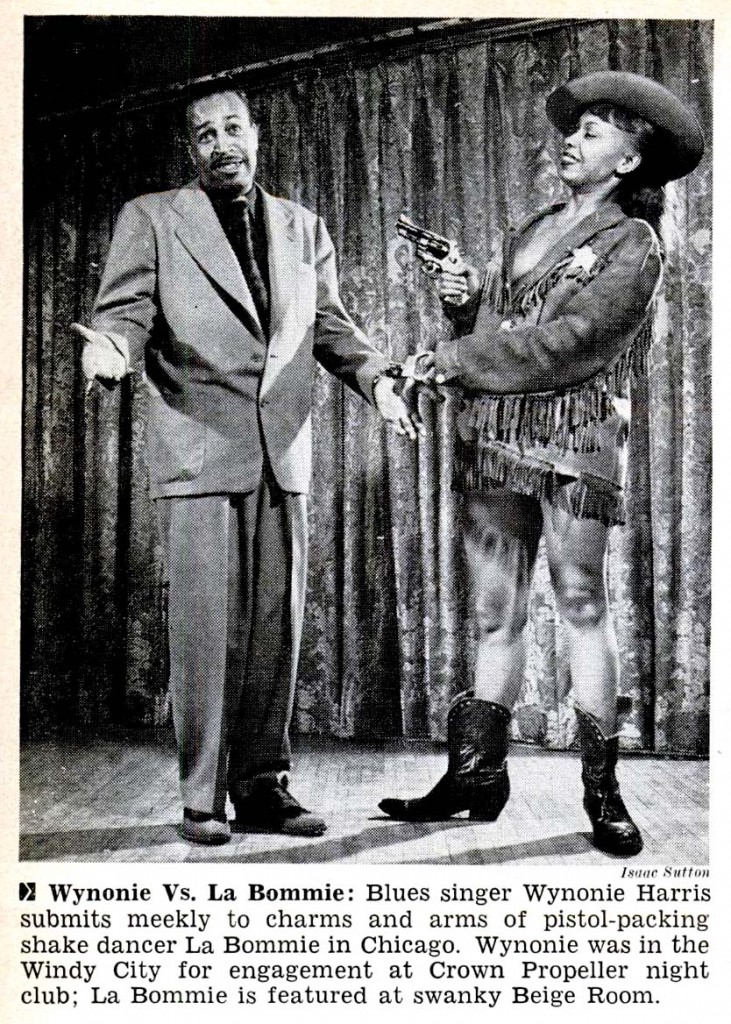 By the time Harris landed back in L.A. in 1945, he was a seasoned professional who needed no amplification at all, thank you, to get the attention of the hard-drinking patrons of Central Avenue’s crowded nightclubs. He joined forces that year with Johnny Otis to record another R&B hit, this one for the Philo label: Around the Clock, Pt. 1 And that set off a flurry of sessions for several other independent labels, including Apollo, Hamp-Tone (vibraphonist Lionel Hampton’s imprint) and Bullet.
By the time Harris landed back in L.A. in 1945, he was a seasoned professional who needed no amplification at all, thank you, to get the attention of the hard-drinking patrons of Central Avenue’s crowded nightclubs. He joined forces that year with Johnny Otis to record another R&B hit, this one for the Philo label: Around the Clock, Pt. 1 And that set off a flurry of sessions for several other independent labels, including Apollo, Hamp-Tone (vibraphonist Lionel Hampton’s imprint) and Bullet.
Which brings us to Wynonie’s glory years (roughly, 1947 to 1954), when he recorded one jump blues gem after another for Cincinnati’s King Records.
As we pointed out in this post, few labels (major or independent) could rival King’s output from the late Forties to the early Sixties – The Stanley Brothers, The Delmore Brothers, Moon Mullican, Cleanhead Vinson, Little Willie John, Freddie King, Hank Ballard, James Brown, etc. King was a true test for Harris’ fledgling career. And if Nathan had any doubts about his new find, they were quickly dispelled by one of Wynonie’s first singles for the label – a 1948 remake of a Roy Brown single that reached the top of the R&B charts and presaged the arrival of rock ‘n roll with Elvis’ version six years later: Good Rockin’ Tonight
Harris became a big draw on the R&B package tours that crisscrossed the country in the early Fifties. One drew about 10,000 fans to the Cleveland Arena in 1953 thanks to the promotional support of DJ Alan Freed, who hosted “The Moondog House” on WJW radio. The tour was headlined by Ruth Brown and included Buddy & Ella Johnson, jazz giant Lester Young, The Clovers and boxing champ Joe Louis, who was looking for any opportunity to pay off debt.
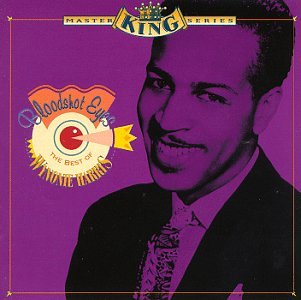 I have my favorite songs from Wynonie’s King years (including the previous tune and the ones sampled up front). Here’s a hard-rockin’ blues that helped introduce Harris’ moniker to the record-buying public in 1950. But his non-musical greeting might’ve been even more impressive. According to Galen Gart’s notes for Bloodshot Eyes, The Best of Wynonie Harris, “Wynonie would typically announce his entrance at his soirees with more than just a dash of bravado, telling his guests, ‘Mr. Blues is back in town, and I have enough money to air-condition Hell!’” Mr. Blues is Coming to Town
I have my favorite songs from Wynonie’s King years (including the previous tune and the ones sampled up front). Here’s a hard-rockin’ blues that helped introduce Harris’ moniker to the record-buying public in 1950. But his non-musical greeting might’ve been even more impressive. According to Galen Gart’s notes for Bloodshot Eyes, The Best of Wynonie Harris, “Wynonie would typically announce his entrance at his soirees with more than just a dash of bravado, telling his guests, ‘Mr. Blues is back in town, and I have enough money to air-condition Hell!’” Mr. Blues is Coming to Town
During the King years, Nathan recorded Harris in New York City and Linden, NJ with some of the best players in the business – Millinder and band, Hal Singer and Red Prysock on tenor sax, Ted Buckner on alto sax, Mickey Baker on guitar, etc. But it’s hard to top the label’s regular session crew in Cincinnati – especially pianist Sonny Thompson and band, heard to great effect on Freddie King’s signature songs (this one probably features Bill Johnson on guitar): Bring It Back
Wynonie scored another big R&B hit with this cover of a tune co-written by one of King’s many hillbilly artists, Hank Penny. I’m sure Nathan was pleased, since he owned the publishing rights to all of his artists’ songs (this one gave him a “two-fer,” since Penny’s single had already climbed the C&W charts). Bloodshot was recorded in NYC with some top-shelf talent, including Big John Greer on sax: Bloodshot Eyes
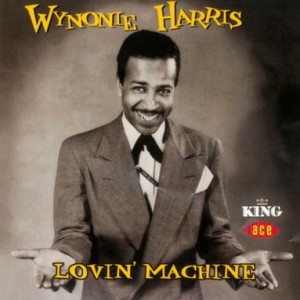 Harris’ final R&B hit (from 1952) is one of his best, featuring the locomotive sound of Todd Rhodes and his Orchestra. It’s hard not to appreciate the lyrics by Lambert Merritt, which seem to describe a prototype for Woody Allen’s Orgasmatron from the movie Sleeper: “Well you pull the lever on the right, two arms jump out… wrap all around you, make you scream and shout” (Merritt might have had Wynonie in mind when he added the line “when my machine finishes, that ain’t all – out comes a bottle of Hadacol!”). Lovin’ Machine
Harris’ final R&B hit (from 1952) is one of his best, featuring the locomotive sound of Todd Rhodes and his Orchestra. It’s hard not to appreciate the lyrics by Lambert Merritt, which seem to describe a prototype for Woody Allen’s Orgasmatron from the movie Sleeper: “Well you pull the lever on the right, two arms jump out… wrap all around you, make you scream and shout” (Merritt might have had Wynonie in mind when he added the line “when my machine finishes, that ain’t all – out comes a bottle of Hadacol!”). Lovin’ Machine
If you read our posts on Amos Milburn, The “5” Royales and Little Willie John (among other R&B legends), it shouldn’t surprise you that Harris’ fortunes faded with the arrival of rock ‘n roll and everything that followed. Of course some of his decline was self-inflicted, as years of smoking, heavy drinking and carousing (whatever that implies) finally caught up with him.
King let Harris go in 1954, although the label brought him back for two more sessions in ‘57 that resulted in at least one keeper. Then things more or less ground to a halt in the Sixties as his health worsened. He cut a handful of forgettable tracks for several labels (including Chess) and even ran a few taverns in New York and on the West Coast (probably not the best occupation for a full-blown alcoholic).
One of his final performances took place in 1967 at Harlem’s Apollo Theater, where he was joined by Big Joe Turner, T-Bone Walker, Big Mama Thornton and Jimmy Witherspoon – a heavenly lineup for jump blues fans. Then he passed away two years later at the age of 53 from esophageal cancer.
Although his death went virtually unnoticed at the time, he’s now recognized as a major influence on the first generation of rock ‘n rollers. So raise a glass – yes, even you bearded, bespectacled and overly sensitive indie rockers – to the man they called Mr. Blues.
No live footage of Wynonie Harris on YouTube… Might as well raise another glass:





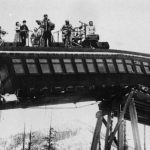
Superb feature. You are quite correct about the lack of obituaries – what follows is the only one! I’ll attempt to locate Pete Lowry’s obit in Blues Unlimited 58. Pity that Tony Collins excellent biography of Harris is now long out of print, commanding “silly sums of money”.
Death of a Blues Shouter
By Max Jones
Melody Maker, August 16, 1969, p. 16
TITLES like “Good Mornin’ Judge,” “Lovin’ Machine,” “Bloodshot Eyes,” “Keep On Churnin”‘ and “All She Wants To Do Is Rock” may not ring a bell with many British blues or jazz buffs today.
But they did in the early Fifties when a sharp-looking singer named Wynonie Harris was enjoying what you might call a vogue on Vogue
These, and quite a few more, sold briskly on the Vogue label at that time, when the jazz form of R&B was enjoying a degree of commercial success.
After a while Wynonie, who used to be billed as “Mr Blues,” faded from the record scene — an unjust fate in view of his many engaging qualities.
Not a lot had been heard of him this year. Then Freddie King told me recently that Harris was seriously ill out on the West Coast, unlikely to work again.
Now comes news that the singer has died in Los Angeles at the age of 54.
It seems odd, in view of the shortage of good band blues vocalists, that more was not done with Wynonie. He never made it to this country although he should have proved popular with the audiences that welcomed Jimmy Rushing, Joe Turner and Jimmy Witherspoon.
For this is the kind of strong singer he was — a man who handled blues and jazz material in a jazz context.
Wynonie sang blues often, but in a lumping, exuberant way which had much to do with Turner and the swing school of blues belters, also something to do with Louis Jordan’s R&B approach and the style of a variety of jazz singers.
Listening to “Do It Again Please ” on Vogue EP (no longer available), with its Basie-like feel to the band backing, I was reminded of Louis Prima by the high, slightly raspy sound of Wynonie’s singing. Even T-Bone may be in the mix.
Elsewhere, and particularly on the “Battle Of The Blues” track on Liberty’s “Blues Uptown” LP, where Harris and Turner share the stage, the jauntiness and thrust of his blues delivery are similar to Big Joe’s.
Charles Keil, in his Urban Blues book, writes of the influence of the Western bands and of Kansas City on modern blues developments.
“Other singers like Cleanhead Vinson, Jimmy Witherspoon, Joe Turner, Wynonie Harris, Atbee Stidham — carriers of the Kansas City shouting tradition — were also appearing in the South and Midwest.
“Many of these men had records that sold more than a million copies to an almost entirely Negro market — a market that came to be known as rhythm-and-blues.”
Wynonie’s “Bloodshot Eyes,” which isn’t a blues, was that type of hit.
Harris’s early life has not been written up much. He was born in Omaha, Nebraska, it seems, and started in music as a drummer. He then became a dancer, according to Hugues Panassie, “and finally, about 1940, a blues singer.”
He first became known as a vocalist with Lucky Millinder’s band, with which he recorded in 1944. By the next year, he was working as a single and recording in Hollywood under his own name.
With the Johnny Otis band he cut a two sided “Around The Clock Blues,” with Howard McGhee on trumpet. Still on ’45 he made “Wynonie’s Blues” accompanied by Illinois Jacquet’s All Stars (including Charlie Mingus and Bill Doggett) also a raft of sides with Jack McVea’s band, Oscar Pettiford’s and others.
Harris liked singing with jazz musicians, with bands that jumped. He was a rousing, humorous, slick sort of performer who shouted his lyrics — which grew increasingly salty during these years—-with an infectiously lusty spirit.
His real success started when he began, in ’47, a series of records for King, fronting bands which included such men as Dexter Gordon, Clyde Bernhardt, Lips Page, Cat Anderson, Joe Wilder and Milt Buckner.
Like Turner, ‘Spoon, Rushing and a few more big-band bluesmen, Wynonie was a stylist — a personality who performed in front of a band and left the instrumental support in other hands
Marshall Stearns wrote this about him in his Story Of Jazz: “In 1953, when the blues shouter Wynonie Harris played the Apollo Theatre in Harlem, he had a tenor saxophonist honking responses that would curdle the blood of a lesser man.”
We heard some of these monster tenors on his records. They were part and parcel of the uninhibited brand of blues sold by Harris. But on another record he might have Joe Newman, or some such jazz expert, responding to his vocal interpretation.
On the “Battle” track mentioned already, Harris and Turner sing over a formidable 1947 band accompaniment (unhappily it is poorly recorded) which shows as the sleeve note points out, “not a little influence from the bop idiom.”
The most recent report I read of “Mr Blues” was Pete Lowry’s in Blues Unlimited No. 58. Wynonie was back at the Apollo.
This was late last year, and the writer’s verdict was: “Here is a singer of fine talent and humour, possessing a great voice, hoarse but powerful…and when was HE last in a studio? ”
When indeed. It’s a pity that powerful jazz voices have gone out of fashion.
Thanks much Alan. Power, tone, character, swagger, humor… I hate to sound like the “get off my yard” guy, but it’s so hard to find those qualities in contemporary singers who would rather engage in what I like to call melismatic masturbation (in other words, the kind of horseshit that carries the day in those overblown singing competitions). Why suffer through that when you can slap on some Wynonie, Big Maybelle or Big Joe Turner?
What follows is the entry in A Blues Bibliography compiled by Robert Ford and published by Routledge in 2007. Obviously, there’s bound to be a good many more in the past decade!
WYNONIE HARRIS
BH473. Allen, William ‘Hoss’. Wynonie Harris: Good Rockin’ Blues. USA: King KS-1086, 1969; Germany: Bellaphon Bin 8022, 1976; USA: Gusto GD-5040X(2): 1976.
BH474. Anderson, Clive. Wynonie Harris v. Roy Brown: Battle of the Blues. UK: Charly R&B 37, 1986.
BH475. Anon. “Wynonie and Darnell Hit Blue Parade.” Chicago Defender (9 Feb 1952): 22.
BH476. Anon. “Wynonie’s ‘Hey Bob’ Juke Box Favorite.” Chicago Defender (13 Jul 1946): 16.
BH477. Anon. “Wynonie ‘Mr. Blues’ Harris.” Rocking Regards no. 17 (Feb 1980): 4-8.
BH478. Bernholm, Jonas; Notini, Per; Love, Preston. Wynonie Harris: Oh Babe! Sweden: Route 66 KIX-20, 1982.
BH479. Bernholm, Jonas. Wynonie Harris: Playful Baby. Sweden: Route 66 KIX-30, 1986.
BH480. Bogaert, Karel. “Harris, Wynonie.”, in Blues Lexicon, p. 145 (Item E110).
BH481. Bruynoghe, Yannick. “Harris, Wynonie.”, in Jazz Era: The Forties, ed. S. Dance, p. 126 (Item E128).
BH482. Clarke, Donald. “Harris, Wynonie.”, in The Penguin Encyclopedia of Popular Music. 2nd. ed., p. 554 (Item E125).
BH483. Collins, Tony. “Mr. Blues: Wynonie Harris: A Guide to the Records of Famous Blues Artists.” Juke Blues no. 6 (Autumn 1986): 24-25.
BH484. Collins, Tony. Rock Mr. Blues: The Life and Music of Wynonie Harris. Milford: Big Nickel, 1995. 179 pp.
BH485. Collins, Tony. “Rock Mr. Blues: Wynonie Harris and the Big Rhythm and Blues Show of 1953.” Blues & Rhythm no. 92 (Sep 1994): 4-6.
BH486. Collins, Tony. Wynonie Harris: Lovin’ Machine. UK: Ace CDCHD 843, 2002.
BH487. Collins, Tony. Wynonie Harris: Women, Whiskey and Fish Tails. UK: Ace CDCHD 457, 1993.
BH488. Cressant, Pierre. “Wynonie ‘Mr Blues’ Harris.” Jazz Hot no. 50 (Dec 1950): 20, 24.
BH489. D’Arch Smith, Timothy. “Wynonie Harris: Rock Mr Blues (Charly, 1985).”, in Peepin’ in a Seafood Store, pp. 84-87. Norwich: Russell, 1992.
BH490. Gart, Galen. Bloodshot Eyes: The Best of Wynonie Harris. USA: King R2 71544, 1994.
BH491. Glover, Henry. Wynonie Harris & Eddie Vinson: Jump Blues. UK: Polydor 2343-048, c1973.
BH492. Goldman, John. “Wynonie Harris Singles.” New Kommotion Magazine no. 14 (Winter 1977): 21.
BH493. Hardy, Phil; Laing, Dave (eds). “Wynonie Harris.”, in The Encyclopedia of Rock. Vol. 1, p. 160 (Item E145).
BH494. Harris, Sheldon. “Harris, Wynonie ‘Mr Blues’.”, in Blues Who’s Who. 5th ed., pp. 215-216 (E146).
BH495. Hildebrand, Lee. “Wynonie Harris.”, in Stars of Soul and Rhythm & Blues, pp. 91-92. New York: Billboard, 1994.
BH496. Holland, Ted. “Wynonie Harris.”, in This Day in African-American Music, p. 99 (E157).
BH497. Larkin, Colin (ed). “Harris, Wynonie.”, in The Guinness Encyclopedia of Popular Music, p. 1093 (E165). Reprinted in The Guinness Who’s Who of Blues. 2nd ed., p. 162 (E166). Reprinted in The Virgin Encyclopedia of the Blues, p. 151 (E169).
BH498. Love, Preston; Weine, Bengt; Kochakian, Dan. “Mr. Love Talks About Mr. Blues: Preston Love on Wynonie Harris.” Whiskey, Women and … no. 8 (Mar 1982): 4 pp.
BH499. McCarthy, Albert. “Harris, Wynonie.”, in Jazz on Record, ed. A.J. McCarthy, p. 124 (Item E378).
BH500. Miller, James. “Good Rockin’ Tonight.”, in Almost Grown: The Rise of Rock, pp. 25-34. London: William Heinemann, 1999.
BH501. Mohr, Kurt. “Discography of Wynonie Harris.” Discophile no. 14 (Oct 1950): 14-15. (NOTE: With additions/corrections in Discophile no. 19 ( 1951): 10; Discophile no. 24 (1952): 17; Discophile no. 25 (1952): 10-11).
BH502. Moonoogian, George A. “Wynonie Harris Discography.” Goldmine no. 41 (Oct 1979): 13-14. (NOTE: With additions/corrections in Goldmine no. 43 (1979), no. 46 (1980), no. 48 (1980)).
BH503. Mourot, Christophe. “Wynonie Harris: Rockin’ the Blues.” Soul Bag no. 164 (Fall 2001): 34-36.
BH504. Otis, Johnny. “On the Bandstand with Johnny Otis and Wynonie Harris.”, in The Pop, Rock, and Soul Reader: Histories and Debates, ed. D. Brackett. New York: Oxford University Press, 2005. (NOTE: Extracted from item BO113).
BH505. Panassié, Hugues; Gautier, Madeleine. “Harris, Wynonie.”, in Dictionary of Jazz, p. 103 (Item E182).
BH506. Penny, Dave; Young, C. Wynonie Harris: Good Rockin’ Tonight. UK: Charly CD 244, 1990.
BH507. Penny, Dave. Wynonie Harris: Good Rocking Tonight. UK: King KCD6002, 1997.
BH508. Penny, Dave; Burke, Tony. “The Wynonie Harris Story: Whiskey and Jellyroll Blues.” Blues & Rhythm no. 16 (Feb 1986): 4-13.
BH509. Rehnberg, Bert. “Wynonie ‘Mr Blues’ Harris.” Jazz Music [Germany] (Nov/Dec 1957): 10-11.
BH510. Ritvanen, Juhani. “Wynonie Harris – Discografia.” Blues News [Finland] no. 78 (1982): 8-10.
BH511. Ritvanen, Juhani. “Wynonie ‘Mr. Blues’ Harris – Shoutereiden Kuningas.” Blues News [Finland] no. 29 (1974): 14-16.
BH512. Russell, Tony (ed). “Wynonie Harris.” The Blues Collection no. 90 (1992+).
BH513. Russell, Tony. “Wynonie Harris (1915-1969).”, in The Blues: From Robert Johnson to Robert Cray, p. 117 (Item A1904).
BH514. Santelli, Robert. “Harris, Wynonie.”, in The Big Book of Blues, pp. 169-170 (Item E202).
BH515. Shadwick, Keith. “Wynonie Harris.”, in Blues: Keeping the Faith, p. 122 (Item E204).
BH516. Sinclair, John. “Harris, Wynonie.”, in Encyclopedia of the Blues. Vol. 1: A-J, ed. E. Komara, p. 413 (Item E162).
BH517. Slaven, Neil. The Essential Wynonie Harris: Bloodshot Eyes. UK: Indigo IGODCD 2516, 2002.
BH518. Southern, Eileen. “Harris, Wynonie (‘Mr Blues’).”, in Biographical Dictionary of Afro-American and African Musicians, p. 169 (Item E208).
BH519. Stewart-Baxter, Derrick. “Wynonie Harris and Blind Boy Fuller.” Jazz Journal 6, no. 9 (Sep 1953): 13-14.
BH520. Tosches, Nick. “Wynonie Harris: The Man Who Shook Down the Devil.” Creem 11, no. 3 (Aug 1979): 48+. Reprinted in Unsung Heroes of Rock ‘n’ Roll, pp. 37-43. New York: Charles Scribner’s Sons, 1984.
BH521. Visser, Joop. Wynonie Harris: Rockin’ the Blues. UK: Proper Properbox 20, 2001.
BH522. Waxie Maxie. “Wynonie (Mr. Blues) Harris.” Record Collector no. 12 (Aug 1980): 10-11.
BH523. Waxie Maxie. “Wynonie (Mr. Blues) Harris Discography.” Record Collector no. 12 (Aug 1980): 12.
BH524. Waxie Maxie. Wynonie Harris: Rock Mr. Blues. UK: Charly CRB 1097, 1985.
BH525. Weine, Bengt; Notini, Per. Wynonie Harris: Mr Blues is Coming to Town. Sweden: Route 66 KIX-3, 1977.
Obituaries: B.M.I.: The Many Worlds of Music (Nov 1969): 4. Jazz Magazine [France] no. 169/170 (Sep 1969): 12.
BH526. Gleason, Ralph. “Wynonie Harris.” New York Post (2 Sep 1969).
BH527. Jones, Max. “Death of a Blues Shouter.” Melody Maker (16 Aug 1969): 16.
See also: Chicago Defender (23 Aug 1975): A4. Jazz Hot no. 56 (1951). Jazz Hot no. 66 (1952). Jazz Hot no. 83 (1953). New York Age (3 Sep 1949).
He’s a fave!